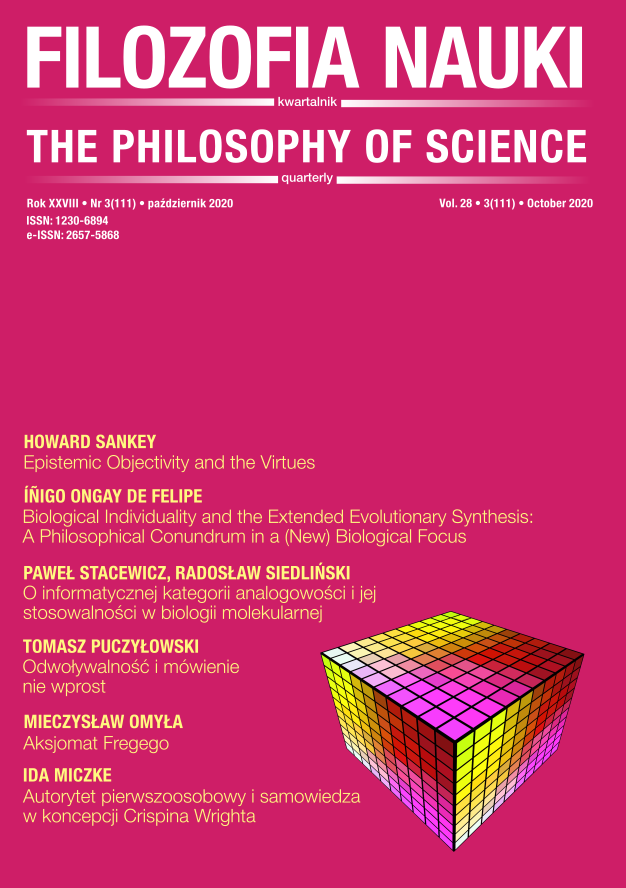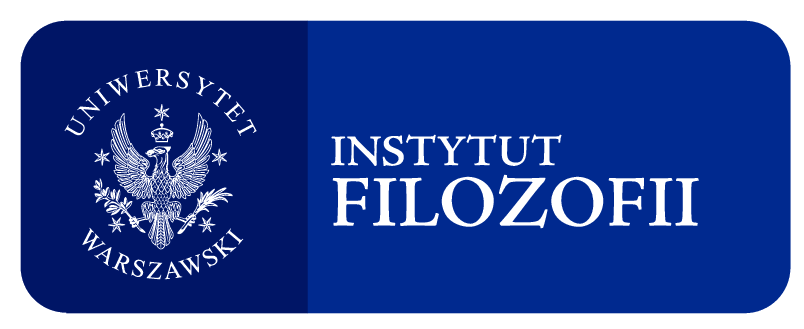On the Computer-Science Category of Analogicity and the Possibility of its Application in Molecular Biology
DOI:
https://doi.org/10.14394/filnau.2020.0015Keywords:
analog computation, analogicity, computer science, empirical computation, molecular biology, philosophy of computing, protein foldingAbstract
The main aim of this paper is to justify the thesis that in molecular biology — in the scope of phenomena fundamental for the functioning of the cell — a significant role is played by analog (nondiscrete) information, which can be described in computational terms. It is a methodological thesis, indicating a certain direction of advancing new biological hypotheses. This aim is realized in two stages. In sections 1 and 2 we discuss the computer-science concept of analogicity, generally describing different concepts of analog-continuous and analog-empirical computations, as well as discussing the relationship between analogicity and digitality. In sections 3 and 4 we analyze some components of the process of protein formation, emphasizing that an adequate description of this process requires taking into account information of an analog nature, which, with a certain research attitude, can be described, but also used, computationally.
References
Anfinsen C. B. (1973), Principles that Govern the Folding of Protein Chains, „Science” 181(4096). https://doi.org/10.1126/science.181.4096.223
Bekenstein J. D. (1981), Universal Upper Bound on the Entropy-to-Energy Ratio for Bounded Systems, „Physical Review” D 23(2), 287-298. https://doi.org/10.1103/PhysRevD.23.287
Blum L., Shub M., Smale S. (1989), On a Theory of Computation and Complexity over the Real Numbers: NP—Completeness, Recursive Functions and Universal Machines, „Bulletin of the American Mathematical Society (New Series)” 21, 1-46. https://doi.org/10.1090/S0273-0979-1989-15750-9
Bour P., Kubelka J., Keiderling T. A. (2002), Ab Initio Quantum Mechanical Models of Peptide Helices and Their Vibrational Spectra, „Biopolymers” 65(1), 45-59. https://doi.org/10.1002/bip.10224
Chin D., Means A. R. (2000), Calmodulin: A Prototypical Calcium Sensor, „Trends in Cell Biology” 10, 322-328. https://doi.org/10.1016/S0962-8924(00)01800-6
Cobb M. (2017), Największa tajemnica życia. Jak rozszyfrowano kod genetyczny, tłum. A. Tuz, Warszawa: Prószyński i S-ka.
Copeland J. (2002), Hypercomputation, „Mind and Machines” 12(4), 461-502. https://doi.org/10.1023/A:1021105915386
Costa J. F., Graça D. (2003), Analog Computers and Recursive Functions over the Reals, „Journal of Complexity” 5(19), 644-664. https://doi.org/10.1016/S0885-064X(03)00034-7
Deutsch D. (1985), Quantum Theory, the Church—Turing Principle and the Universal Quantum Computer, „Proceedings of the Royal Society A” 400, 97-117. https://doi.org/10.1098/rspa.1985.0070
Downes S. M. (2006), Biological Information [w:] The Philosophy of Science: An Encyclopedia, S. Sarkar, J. Pfeifer (eds.), New York: Routledge, 64-68.
Eed J. (2012), Factors Affecting Enzyme Activity, „ESSAI” 10, 48-51.
Ellis R. J. (1996), Discovery of Molecular Chaperones, „Cell Stress & Chaperones” 1(3), 155-160. https://doi.org/10.1379/1466-1268(1996)001<0155:DOMC>2.3.CO;2
Fraenkel A. S. (1993), Complexity of Protein Folding, „Bulletin of Mathematical Biology” 55(6), 1199-1210. https://doi.org/10.1016/S0092-8240(05)80170-3
Godfrey-Smith P., Sterelny K. (2016), Biological Information [w:] The Stanford Encyclopedia of Philosophy (Summer 2016 Edition), Edward N. Zalta (ed.), https://stanford.io/365r6zg.
Harel D. (2000), Rzecz o istocie informatyki. Algorytmika, Warszawa: Wydawnictwa Naukowo-Techniczne.
Hogarth M. (1994), Non-Turing Computers and Non-Turing Computability, „PSA” 1, 126-138. https://doi.org/10.1086/psaprocbienmeetp.1994.1.193018
Ifrah G. (2006), Historia powszechna cyfr, t. 2, tłum. K. Marczewska, K. Szeżyńska-Maćkowiak, Warszawa: W.A.B.
Jaswal S. S., Truhlar S. M. E., Dill K. A., Agard D. A. (2005), Comprehensive Analysis of Protein Folding Activation Thermodynamics Reveals a Universal Behavior Violated by Kinetically Stable Proteases, „Journal of Molecular Biology” 347, 355-366. https://doi.org/10.1016/j.jmb.2005.01.032
Kari L., Rozenberg G. (2008), The Many Facets of Natural Computing, „Communications of the ACM” 10(51), 72-83. https://doi.org/10.1145/1400181.1400200
Kozłowski J. (2011), Czy teorię ewolucji można zmatematyzować? [w:] Ewolucja życia i ewolucja Wszechświata, J. Mączka, P. Polak (red.), Kraków: Copernicus Center Press, 75-84.
Kubelka J., Hofrichter J., Eaton W. A. (2004), The Protein Folding “Speed Limit”, „Current Opinion in Stuctural Biology” 14, 76-88. https://doi.org/10.1016/j.sbi.2004.01.013
Kulka Z., Nadachowski N. (1979), Analogowe układy scalone, Warszawa: Wydawnictwa Komunikacji i Łączności.
Kulka Z., Nadachowski M. (1982), Wzmacniacze operacyjne i ich zastosowanie, cz. 2, Warszawa: Wydawnictwa Komunikacji i Łączności.
Kuźnicki J., Filipek A. (1997), Różnorodność i wielofunkcyjność białek wiążących wapń (CaBP), „Kosmos. Problemy nauk biologicznych” 4(237), 603-608.
Levinthal C. (1968), Are There Pathways for Protein Folding?, „Journal de Chimie Physique et de Physico-Chimie Biologique” 65, 44-45. https://doi.org/10.1051/jcp/1968650044
Levinthal C. (1969), How to Fold Graciously, „University of Illinois Bulletin” 67(41), 22-24.
Luscombe N. M., Greenbaum D., Gerstein M. (2001), What is Bioinformatics? A Proposed Definition and Overview of the Field, „Methods of Information in Medicine” 40, 346-358. https://doi.org/10.1055/s-0038-1634431
Łuków P., Żekanowski C. (2005), Pojęcie genu i genocentryczny paradygmat biologii, „Przegląd Filozoficzny — Nowa Seria” 14(53), 85-105.
Maynard Smith J. (2000), The Concept of Information in Biology, „Philosophy of Science” 67, 177-194. https://doi.org/10.1086/392768
Mironov A. A., Fickett J. W., Gelfand M. S. (1999), Frequent Alternative Splicing of Human Genes, „Genome Research” 9, 1288-1293. https://doi.org/10.1101/gr.9.12.1288
Moffat B. (2009), A Reexamination of Biological Information from the Perspective of Practice, http://philsci—archive.pitt.edu/4803/
Moore C. (1996), Recursion Theory on the Reals and Continous-Time Computation, „Theoretical Computer Science” 162, 23-44. https://doi.org/10.1016/0304-3975(95)00248-0
Mycka J. (2010), Obliczenia dyskretne i ciągłe jako realizacje antropomorficznej i fizycznej koncepcji efektywnej obliczalności [w:] Światy matematyki. Tworzenie czy odkrywanie, I. Bondecka-Krzykowska, J. Pogonowski (red.), Poznań: Wydawnictwo UAM, 247-260.
Mycka J. M., Piekarz M. (2004), Przegląd zagadnień obliczalności analogowej [w:] Algorytmy, metody i programy naukowe, S. Grzegórski, M. Miłosz, P. Muryjas (red.), Lublin: Polskie Towarzystwo Informatyczne, 125-132.
Pauwels K., Van Molle I., Tommassen J., Van Gelder P. (2007), Chaperoning Anfinsen: The Steric Foldases, „Molecular Microbiology” 64(4), 917-922. https://doi.org/10.1111/j.1365-2958.2007.05718.x
Pour-El M. B., Richards J. I. (1989), Computability in Analysis and Physics, Berlin: Springer. https://doi.org/10.1007/978-3-662-21717-7
Roterman I., Konieczny L., Spólnik P. (2017), Biologia systemów. Strategia działania organizmu żywego, Warszawa: Wydawnictwo Naukowe PWN.
Rozenberg G., Back T., Kok J. N. (2012), Handbook of Natural Computing, Berlin–Heidelberg: Springer. https://doi.org/10.1007/978-3-540-92910-9
Rubel L. (1993), The Extended Analog Computer, „Advances in Applied Mathematics” 14, 39-50.https://doi.org/10.1006/aama.1993.1003
Sarkar S. (1996), Biological Information: A Skeptical Look at Some Central Dogmas of Molecular Biology [w:] The Philosophy and History of Molecular Biology: New Perspectives, S. Sarkar (ed.), Dordrecht: Kluwer. https://doi.org/10.1007/978-0-585-31233-0_11
Schmucker D., Clemens J. C., Shu H., Worby C. A., Xiao J., Muda M., Dixon J. E., Zipursky L. (2000), Drosophila Dscam Is an Axon Guidance Receptor Exhibiting Extraordinary Molecular Diversity, „Cell” 101, 671-684. https://doi.org/10.1016/S0092-8674(00) 80878-8
Shagrir O. (2004), Super-Tasks, Accelerating Turing Machines and Uncomputability, „Theoretical Computer Science” 317, 105-114. https://doi.org/10.1016/j.tcs.2003.12.007
Shannon C. (1941), Mathematical Theory of the Differential Analyzer, „Journal of Mathematics and Physics” 20, 337-354. https://doi.org/10.1002/sapm1941201337
Siedliński R. (2016), Turing Machines and Evolution. A Critique of Gregory Chaitin’s Metabiology, „Studies in Logic, Grammar and Rhetoric” 48(61), 133-150. https://doi.org/10.1515/slgr-2016-0059
Siegelmann H. T. (1998), Neural Networks and Analog Computation: Beyond the Turing Limit, Boston: Springer. https://doi.org/10.1007/978-1-4612-0707-8
Sohl J. L., Jaswal S. S., Agard D. A. (1998), Unfolded Conformations of α-Lytic Protease are More Stable than its Native State, „Nature” 395, 817-819. https://doi.org/10.1038/27470
Stacewicz P. (2017a), O redukcji informacji do danych [w:] Różne oblicza informacji, P. Stacewicz (red.), Warszawa: Oficyna Wydawnicza Politechniki Warszawskiej, 11-21.
Stacewicz P. (2017b), O różnych sposobach rozumienia analogowości w informatyce, „Semina Scientiarum” 16, 121-137. https://doi.org/10.15633/ss.2486
Stacewicz P. (2019), Uncomputable Numbers and the Limits of Coding in Computer Science, „Studia Semiotyczne” 30, 107-127.
Stacewicz P. (2020), Analogicity in Computer Science: Methodological Analysis, „Studies in Logic, Grammar and Rhetoric” 63(76), w druku.
Szathmáry E., Maynard Smith J. (1995), The Major Evolutionary Transitions, „Nature” 374, 227-232. https://doi.org/10.1038/374227a0
Szcześniak M., Szweykowska-Kulińska Z. (2009), Regulacja alternatywnego splicingu, „Postępy Biologii Komórki” 36(1), 23-35.
Turing A. M. (1936), On Computable Numbers, with an Application to the Entscheidungsproblem, „Proceedings of the London Mathematical Society” 42, 230-265. https://doi.org/10.1112/plms/s2-42.1.230
Zwanzig R., Szabo A., Bagchi B. (1992), Levinthal’s Paradox, „PNAS” 89, 20-22. https://doi.org/10.1073/pnas.89.1.20



















 Filozofia Nauki/The Philosophy of Science | ISSN 1230-6894 | e-ISSN 2657-5868
Filozofia Nauki/The Philosophy of Science | ISSN 1230-6894 | e-ISSN 2657-5868